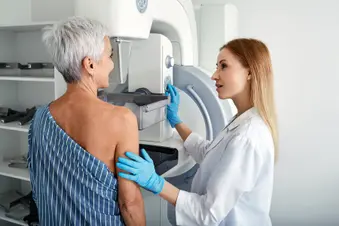
A mammogram, or breast X-ray, is the best way to find breast cancer early, when it’s easy to treat. If you’re worried about having a mammogram, it can help to know the facts.
Why a Mammogram Is Important
Mammograms can find cancer before you notice a lump or have symptoms. It’s hard to notice a growth or lump until it’s the size of a pea. But a mammogram can detect it sooner, when it’s very small.
When breast cancer is found early, it’s easier to treat, you have more treatment options, and your risk of dying from cancer is lower.
If breast cancer runs in your family, it’s especially important to have regular mammograms.
“As someone in her 30s with a strong family history of breast cancer, I’ve been encouraged to start my routine mammogram screenings earlier than average,” says Kristina Kasparian, a 38-year-old writer in Montreal.
Kasparian has family members who had breast cancer when they were young, so her doctor recommended that she start screenings early. “I was 37 when we decided I should go for my first mammogram,” she says.
New Screening Guidelines
The guidelines for mammogram screenings recently changed. The general recommendation is to have a mammogram every other year, beginning at age 40. Some organizations recommend having one every year.
This was lowered from age 50 because more women in their 40s are being diagnosed with breast cancer.
There are some drawbacks to early screenings.
Some women have false-positive results. With a false positive, you need more testing. It may cause stress and worry. Extra testing may be expensive and time consuming. Or your doctor may find a cancer that wouldn’t necessarily cause problems or spread, then treat it with surgery or radiation therapy when they may not have been needed.
Even so, the benefits may outweigh the risks. “My doctor warned me that sometimes mammograms in younger patients tend to find cysts and this may cause unnecessary worry,” Kasparian says. “But I was happy I was given the option to be screened early.”
How Family and Friends Can Help
When Kasparian scheduled her first mammogram, she felt good about it. “My parents, sister, husband, and mother-in-law were very supportive of me going to get a mammogram as prevention. We all share the same view that a proactive approach to health is ideal,” she says.
But a few weeks before the appointment, she started to dread it. She was worried it might hurt. She also worried about what she might find out. “I started dreading the potential for bad news,” she says.
It’s normal to worry about what a mammogram might detect, especially if you have a family history of breast cancer. Try to remember that when it’s found early, it’s easier to treat.
Talk about your feelings with a trusted friend or family member. Friendship and emotional support can help you feel better and keep you on track with regular mammograms.
Friends can also support each other during mammograms.
Ask a friend or family member when they’re due for one. Schedule your appointments on the same day. Some clinics have a “bring a friend” program that uses the power of friendship to encourage more women to have mammograms.
What a Mammogram Feels Like
A mammogram is quick. It takes about 10 minutes or less.
During your mammogram, a technician will take four X-rays of your breasts. Two are from the side and two are from the front. They look at everything from your collarbone to your chest.
A mammogram isn’t painful, but you may feel some discomfort when the machine compresses your breast to see through your breast tissue layers.
The amount of discomfort you feel may depend on your breast size and density, where your breasts are positioned on the machine, and where you are in your menstrual cycle.
Kasparian felt some discomfort as the plates of the machine squeezed her breasts. “It’s a bit uncomfortable for some of us,” she says. “The good news is that it’s over quite quickly.”
If you feel pain, tell your technician. They can make adjustments to make you more comfortable. They can also help you feel better by talking you through what’s happening.
Getting the Results
After your mammogram, a radiologist will look for abnormal areas.
Your mammogram will also show your breast density. If you have dense breast tissue, it means you have more supportive tissue than fatty tissue. It’s common to have dense breasts.
Dense breast tissue makes it harder to look for breast cancer. It looks like a solid white area, so it’s harder to see through. If you have dense breast tissue, your doctor may recommend more imaging tests.
If they see something that may look like breast cancer, they may order more tests, like a 3D mammogram, breast MRI, breast ultrasound, or molecular breast imaging (MBI).
Words of Advice
It’s normal to be worried about a mammogram, says Kasparian. To ease your worries and help you through it, she recommends these tips:
- Take someone with you to your appointment.
- Ask as many questions as you need to feel comfortable.
- Be gentle with yourself and know that it’s normal to feel worried about medical screenings.
“Listen to your needs and do whatever it takes to ease your nerves,” Kasparian says. “And remember that ultimately, it’s a good idea to get it done.”
Show Sources
Photo Credit: iStock/Getty Images
SOURCES:
Kristina Kasparian, Montreal.
American Cancer Society: “Breast Cancer Risk Factors You Cannot Change,” “Breast Density and Your Mammogram Report.”
Breast Cancer Research Foundation: “What to Know About New Breast Cancer Screening Recommendations.”
CDC: “Breast Cancer.”
Franciscan Health: “Debunking Top Mammogram Excuses.”
Mayo Clinic: “Dense Breast Tissue: What It Means to Have Dense Breasts.”
OSF Healthcare: “Does It Hurt to Get a Mammogram?”
TriHealth: “Encouraging Loved Ones to Get Mammograms.”
Conway Medical Center: “‘The more the merrier’: Best friends take on annual mammograms together in Conway.”